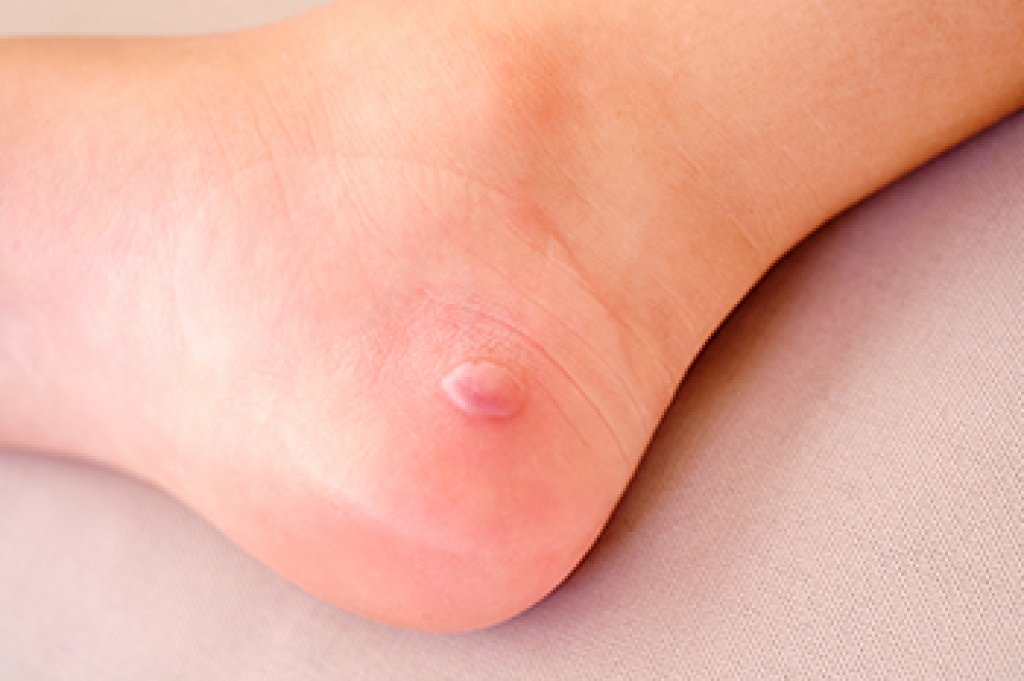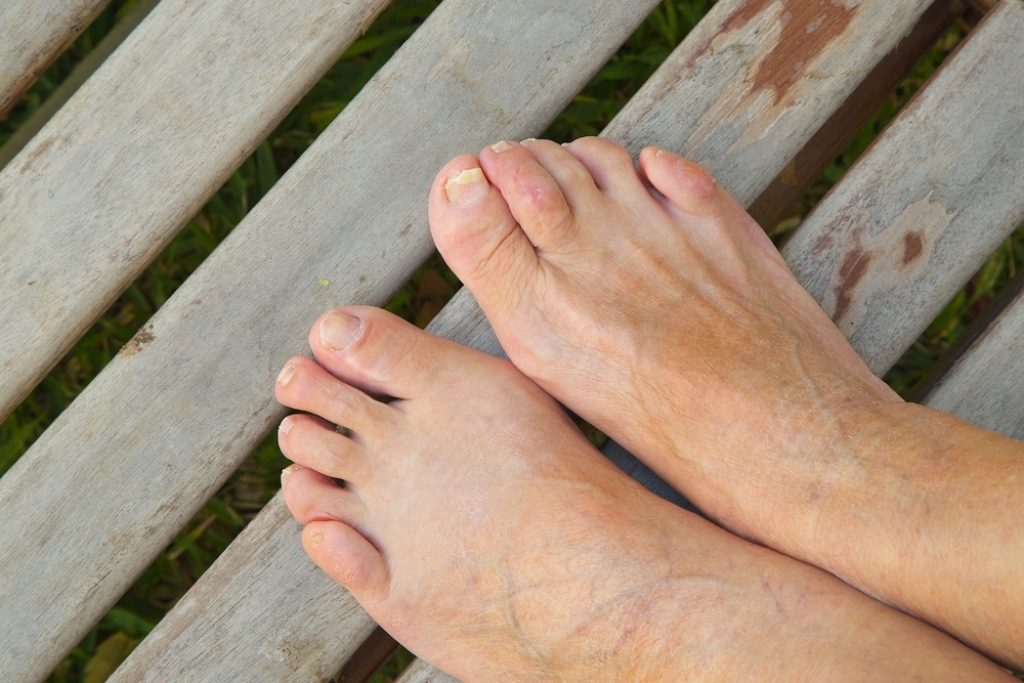Blog
Understanding Friction Blisters on the Feet

Friction blisters are small fluid-filled pockets that form on the skin, often caused by rubbing, heat, or moisture. They commonly develop on the feet from wearing tight or ill-fitting shoes, walking or running long distances, or wearing damp socks. The friction causes the layers of skin to separate, allowing fluid to collect and form a bubble-like sore. Symptoms include redness, tenderness, swelling, and a clear or sometimes bloody fluid inside. Blisters may be painful, especially when pressure is applied, and can become infected if popped or cared for improperly. Infected blisters may appear red, warm, or filled with pus. A podiatrist can diagnose the type and severity of a blister and determine if there is an underlying cause like poor foot mechanics or inappropriate footwear. Treatment includes draining the blister safely to prevent infection, recommending footwear changes, or applying protective padding. If you have a painful friction blister, it is suggested that you schedule an appointment with a podiatrist for effective prevention tips and treatment solutions.
Blisters are prone to making everyday activities extremely uncomfortable. If your feet are hurting, contact Derek Smith, DPM of Oklahoma. Our doctor can provide the care you need to keep you pain-free and on your feet.
Foot Blisters
Foot blisters develop as a result of constantly wearing tight or ill-fitting footwear. This happens due to the constant rubbing from the shoe, which can often lead to pain.
What Are Foot Blisters?
A foot blister is a small fluid-filled pocket that forms on the upper-most layer of the skin. Blisters are filled with clear fluid and can lead to blood drainage or pus if the area becomes infected.
How Do Blisters Form?
Blisters on the feet are often the result of constant friction of skin and material, usually by shoe rubbing. Walking in sandals, boots, or shoes that don’t fit properly for long periods of time can result in a blister. Having consistent foot moisture and humidity can easily lead to blister formation.
Prevention & Treatment
It is important to properly care for the affected area in order to prevent infection and ease the pain. Do not lance the blister and use a Band-Aid to provide pain relief. Also, be sure to keep your feet dry and wear proper fitting shoes. If you see blood or pus in a blister, seek assistance from a podiatrist.
If you have any questions, please feel free to contact our offices located in Ponca City, and Stillwater, OK . We offer the newest diagnostic and treatment technologies for all your foot care needs.
Bunion Surgery and How It Can Help

Bunion surgery is a procedure to correct the bony bump that forms at the base of the big toe. Bunions develop from joint misalignment, often caused by genetics, wearing tight shoes, flat feet, or arthritis. When pain or difficulty walking persists after taking conservative measuress, surgery may be recommended to realign the joint, remove excess bone, and restore function. Types of bunion surgery vary based on the severity of the deformity and may involve soft tissue or bone correction. A podiatrist can evaluate your condition, explain the procedure, and guide you through recovery. If a bunion is limiting your mobility or causing discomfort, it is suggested that you schedule a consultation with a podiatrist who can discuss the benefits of bunion surgery with you.
Foot surgery is sometimes necessary to treat a foot ailment. To learn more, contact Derek Smith, DPM of Oklahoma. Our doctor will assist you with all of your foot and ankle needs.
When Is Surgery Necessary?
Foot and ankle surgery is generally reserved for cases in which less invasive, conservative procedures have failed to alleviate the problem. Some of the cases in which surgery may be necessary include:
- Removing foot deformities like bunions and bone spurs
- Severe arthritis that has caused bone issues
- Cosmetic reconstruction
What Types of Surgery Are There?
The type of surgery you receive will depend on the nature of the problem you have. Some of the possible surgeries include:
- Bunionectomy for painful bunions
- Surgical fusion for realignment of bones
- Neuropathy decompression surgery to treat nerve damage
Benefits of Surgery
Although surgery is usually a last resort, it can provide more complete pain relief compared to non-surgical methods and may allow you to finally resume full activity.
Surgical techniques have also become increasingly sophisticated. Techniques like endoscopic surgery allow for smaller incisions and faster recovery times.
If you have any questions, please feel free to contact our offices located in Ponca City, and Stillwater, OK . We offer the newest diagnostic and treatment technologies for all your foot care needs.
Causes of Hammertoe

Hammertoe is a deformity where the toe bends downward at the middle joint, resembling a hammer. It often affects the second, third, or fourth toe. Common causes include unusually long toe bones, muscle imbalances, rheumatoid arthritis, and foot injuries. Among other causes are bunions pushing against the toe, years of wearing tight or ill-fitting shoes, and genetic factors. Symptoms include pain while wearing shoes, visible bending of the toe, corns or calluses from friction, inflammation, redness, and restricted movement. The toe may appear raised at the joint and feel stiff or sore, especially during walking or pressure. A podiatrist can diagnose hammertoe with a physical exam and imaging, if needed. Treatment options include wearing roomier shoes, using custom orthotics, toe splints or pads, and prescribing anti-inflammatory medication. In more advanced cases, surgical correction may be recommended. If you have developed this condition, it is suggested that schedule an appointment with a podiatrist for appropriate treatment solutions.
Hammertoe
Hammertoes can be a painful condition to live with. For more information, contact Derek Smith, DPM from Oklahoma. Our doctor will answer any of your foot- and ankle-related questions.
Hammertoe is a foot deformity that affects the joints of the second, third, fourth, or fifth toes of your feet. It is a painful foot condition in which these toes curl and arch up, which can often lead to pain when wearing footwear.
Symptoms
- Pain in the affected toes
- Development of corns or calluses due to friction
- Inflammation
- Redness
- Contracture of the toes
Causes
Genetics – People who are genetically predisposed to hammertoe are often more susceptible
Arthritis – Because arthritis affects the joints in your toes, further deformities stemming from arthritis can occur
Trauma – Direct trauma to the toes could potentially lead to hammertoe
Ill-fitting shoes – Undue pressure on the front of the toes from ill-fitting shoes can potentially lead to the development of hammertoe
Treatment
Orthotics – Custom made inserts can be used to help relieve pressure placed on the toes and therefore relieve some of the pain associated with it
Medications – Oral medications such as anti-inflammatories or NSAIDs could be used to treat the pain and inflammation hammertoes causes. Injections of corticosteroids are also sometimes used
Surgery – In more severe cases where the hammertoes have become more rigid, foot surgery is a potential option
If you have any questions, please feel free to contact our offices located in Ponca City, and Stillwater, OK . We offer the newest diagnostic and treatment technologies for all your foot care needs.
Explaining Sinus Tarsi Syndrome

Sinus-tarsi syndrome is a painful condition that involves the tunnel between the talus and calcaneus bones in the foot. This space, known as the sinus tarsi tunnel, contains ligaments and tissues that help control foot stability and movement. Injury from an ankle sprain or repeated strain may damage these ligaments, causing inflammation, instability, and buildup of scar tissue inside the sinus tarsi. People with flat or over-pronated feet may also develop this problem due to pressure that forces the talus and calcaneus closer together. Common signs include pain on the front outer side of the ankle and a sense of weakness or instability, especially while walking on uneven surfaces. A podiatrist can help by performing a thorough foot and ankle exam, ordering imaging tests, and recommending treatment that may include surgery, if necessary. If you have symptoms of sinus-tarsi syndrome, it is suggested that you schedule an appointment with a podiatrist for an exam and appropriate treatment options.
Foot Pain
Foot pain can be extremely painful and debilitating. If you have a foot pain, consult with Derek Smith, DPM from Oklahoma. Our doctor will assess your condition and provide you with quality foot and ankle treatment.
Causes
Foot pain is a very broad condition that could be caused by one or more ailments. The most common include:
- Bunions
- Hammertoes
- Plantar Fasciitis
- Bone Spurs
- Corns
- Tarsal Tunnel Syndrome
- Ingrown Toenails
- Arthritis (such as Gout, Rheumatoid, and Osteoarthritis)
- Flat Feet
- Injury (from stress fractures, broken toe, foot, ankle, Achilles tendon ruptures, and sprains)
- And more
Diagnosis
To figure out the cause of foot pain, podiatrists utilize several different methods. This can range from simple visual inspections and sensation tests to X-rays and MRI scans. Prior medical history, family medical history, and any recent physical traumatic events will all be taken into consideration for a proper diagnosis.
Treatment
Treatment depends upon the cause of the foot pain. Whether it is resting, staying off the foot, or having surgery; podiatrists have a number of treatment options available for foot pain.
If you have any questions, please feel free to contact our offices located in Ponca City, and Stillwater, OK . We offer the newest diagnostic and treatment technologies for all your foot care needs.

